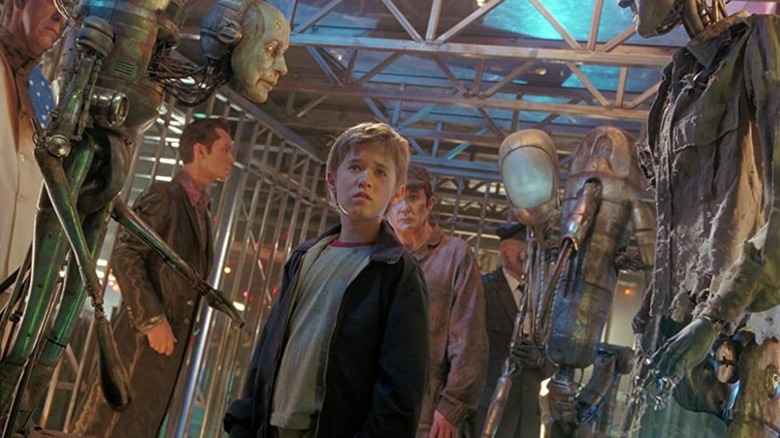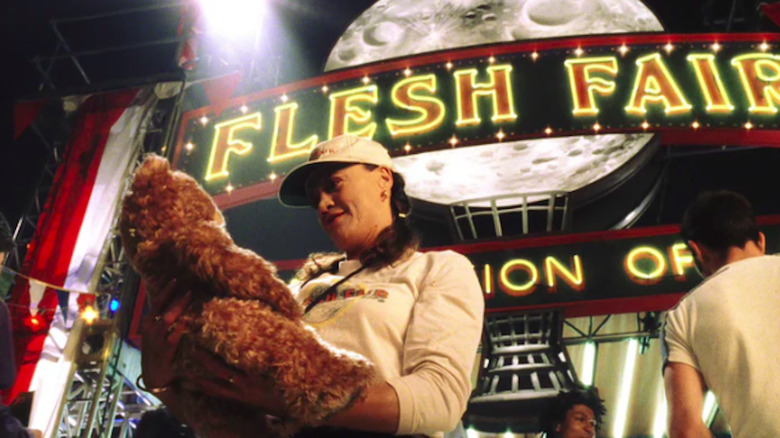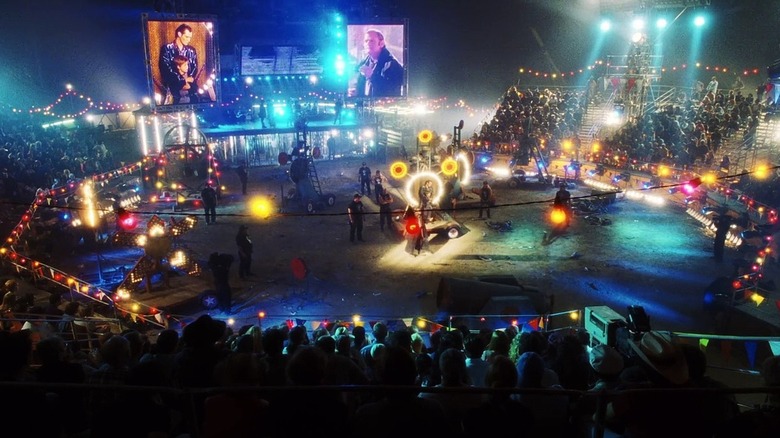The Flesh Fair In Steven Spielberg's A.I. (Dangerously) Didn't Use CGI
When Steven Spielberg's "A.I. Artificial Intelligence" opened theatrically on June 29, 2001, it was freighted with impossible expectations. First of all, many cinephiles didn't consider it a Spielberg film. This was Stanley Kubrick's long-promised homecoming to the science fiction genre, which he'd revolutionized cinematically in 1968 with "2001: A Space Odyssey," and, even though he'd initially approached Spielberg about directing the project in 1985, the Hollywood hitmaker was viewed as a creative conduit of sorts.
This was especially true in the wake of Kubrick's unexpected death two years prior. "A.I." would likely be the last film Kubrick worked on extensively to go before the cameras (this has thus far held true, as we're still waiting on someone to take a crack at his epic biopic "Napoleon"). So while people were excited to see Spielberg's rendition of Kubrick's vision, the doubters were out there. Even with non-escapist masterpieces "Empire of the Sun" and "Schindler's List" in his filmography, some still considered him a sentimentalist.
To this day, some people, despite facts, view "A.I. Artificial Intelligence" as a Spielberg-ized travesty of an unmade Kubrick classic. They point to the "happy ending" where humanoid David's wish to be with his flesh-and-blood mother is granted as proof of Spielberg's meddling (even though all of this was in Kubrick's version). They also nitpicked scenes like the visit to Rouge City and David's brush with destruction at the Flesh Fair as sickeningly tacky.
Frankly, the tackiness was the point, and Spielberg's collaborators went to great lengths to service Kubrick's designs. In fact, particularly with regards to the Flesh Fair, they pushed the safety envelope as far as they could to get the bloodthirsty spectacle sickeningly right.
Bringing futuristic bread-and-circuses to frighteningly real life
In the behind-the-scenes featurette produced for the film's DVD release, special effects supervisor Michael Lanieri discussed the logistics of staging the Flesh Fair, where mechas are destroyed for the enjoyment of human spectators, in as practical a manner as possible (i.e. with only as many CG elements as necessary). In retrospect, he wonders if he might've gotten a tad carried away when he suggested to Spielberg that they could go totally live action with one complicated bit.
According to Lanieri:
"Steven came up with this idea that we would have a couple of cannons, and we had much like a ring, like a coliseum affair, if you will, and out of the cannons have to shoot two people, who travel 50 yards, who go through a ring, who catch on fire, and then hit twelve-foot spinning metal blades, bust up into pieces, and land onstage where this heavy metal group, Ministry, is playing."
When Spielberg signed off on the idea, the great makeup f/x artist and creature constructor Stan Winston whipped up a couple of mechas for Lanieri and his crew to burn up and shred. Be careful what you ask for.
A carefully choreographed, tightly executed several seconds of mayhem
In the featurette, Lanieri explained the rather involved process thusly:
"[W]e purposely put very few insides in them, and we put them on a cable and used a ratchet and pulled them out of the cannon, pulled them through the ring trailing a wire, had suits and clothes made out of flash paper that would ignite... Then literally had a burning projectile that flew into spinning metal blades that busted up into hundreds of pieces and flew all over. And we had to do this inside a ring with 800 extras and a live playing band onstage."
If you're imagining the myriad of ways this could go disastrously wrong, not to worry: Lanieri was way ahead of you. After testing the sequence to make sure it would go off without a single safety concern, he spoke to everyone involved in the scene to make sure they knew what to do. "I had to get the fire department involved, tell them what kind of safety circle we needed," he said. "Talk to the band, talk to the actors, talk to everybody, tell them where they could be... And really not miss."
Since you've never heard of the great Flesh Fair fiasco of 1999, you can rest assured that Lanieri and his crew delivered a visually spectacular set piece without harming anyone save for a couple of poor mechas — though, ironically, I think the most heartbreaking moment of the scene is the CG-enhanced melting of the built-for-kindness nanny humanoid. You can never, ever underestimate humankind's capacity for abject cruelty. This is one of many reasons why I agree with Witney Seibold in viewing Spielberg's film as one of his finest sci-fi efforts.


